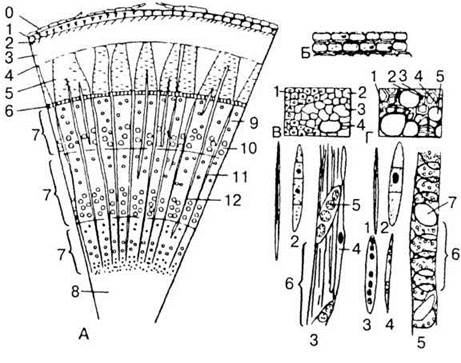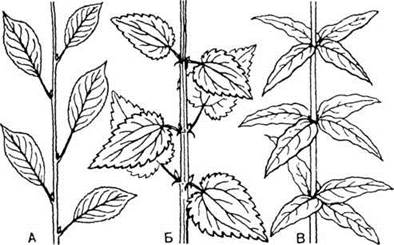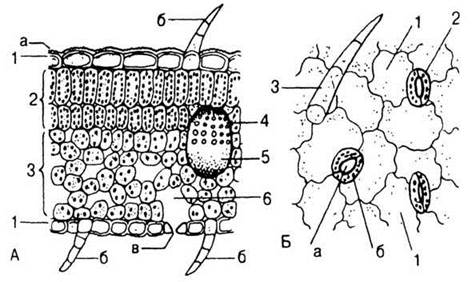STRUCTURE OF A FLOWER PLANT. FUNCTIONS OF ITS BODIES
Escape - Vegetative Organ. SHOOTING SYSTEMS
Escape parts. The shoot is a complex organ consisting of a stem, leaves, and buds (Fig. 5). The stem has nodes and internodes. A node is a section of a stem that contains leaves and buds. The section of the stem between adjacent nodes is called internodes. The angle formed by the leaf and stem above the node is called the leaf axil. The kidneys occupy a lateral position on the node, in the axil of the leaf, they are called lateral or axillary. At the top of the stem is the apical bud.
Rice. 5. Elongated (A) and shortened (B) shoots:
1 - node;
2 - internodes;
3 - leaf;
4 - lateral kidney (or axillary);
5 - leaf axil;
6 - Brunkov's ring (contiguous nodes from fallen scaly leaves);
7 - apical kidney
Escape branches. Variety of shoots by origin. The ability of a shoot to form new daughter shoots from axillary buds is called lateral branching. As a result, an escape system is formed.
There are main, lateral and additional shoots. The beginning of the main shoot bud gives the embryo; this is the first shoot that appears when the seed germinates. The lateral shoot is formed from the lateral or axillary bud. Additional shoots give rise to an additional bud, which is laid on a leaf, internodes or roots.
The location of the escape in space. According to their location in space, the shoots can be erect (for example, in horse sorrel), creeping (creeping clover), recumbent, curly (field bindweed), tenacious (sowing peas).
stem functions. Stem - the axial part of the shoot performs a number of functions. The supporting function is a support for leaves, buds, generative organs; leading - the flow of nutrient solutions through the conductive tissues of the stem from the leaves to all organs and from the roots to the above-ground organs; photosynthetic - the participation of green stems in the formation of organic substances from inorganic substances using the energy of sunlight; storage - accumulation of reserve substances in the tissues of the stem; the function of gas exchange is carried out through special formations of the integumentary tissue - stomata in the skin and buds - in the crust.
The structure of the stems. On a cross section, the stem can be round (sea buckthorn), ribbed (carrot), tetrahedral (nettle), triangular (sedge), etc.
When examining thin transverse sections of the stem under a microscope, one can study its structure at the cellular level.
On the surface of a three-year-old linden stem, the skin is still preserved - the primary integumentary tissue (Fig. 6). But already in the first year of life of the shoot, a cork cambium (lateral meristem) is laid under the skin, which, dividing, forms a cork (secondary integumentary tissue). Cork more reliably protects the internal tissues of the stem from drying out, mechanical damage, penetration of pathogens, etc.

Rice. 6. Scheme of the structure of a three-year-old linden branch on a cross section (A):
0 - the peel has died; 1 - cork; 2 - mechanical tissue of the colenchyma; C - parenchyma of the primary cortex; 4 - starch cells; 5 - bast; 6 - cambium; 7 - growth rings (in wood);
8 - core; 9 - late wood; 10 - early wood; 11 - primary core beam; 12 - secondary core beam.
B - colenchyma (living cells with an unevenly thickened membrane);
B - bast: 1 - fiber; 2 - parenchyma; 3- sieve a tube; 4 - satellite cell; 5 - sieve plate between the segments of the sieve tube; 6 - segment of the sieve tube.
G - wood: I - fiber; 2 - parenchyma; 3 - tracheida; 4 - fibrous tracheid; 5 - vessel; 6 - segment vessels; 7 - opening between two segments
Under the secondary integumentary tissue are the main tissues - layers of colenchyma (mechanical tissue), which border on thin-walled parenchyma cells. The inner layer of the main tissue is the starch-bearing vagina. The main tissues that form the primary bark of the stem are listed. The primary cortex is adjacent to the bast, a conductive tissue that consists of tubes with sieve satellite cells, parenchyma, and fibers. The sieve tube is formed by living cells, on the transverse walls of which there are numerous holes. They form a shell similar to a sieve. Hence the name of the tube. One of the features of tube cells is the absence of a nucleus in them, which disappears as meristematic cells turn into tube segments. Solutions of organic substances move through sieve tubes from leaves to all parts of the plant.
Inside of the bast, closer to the center of the stem, there is wood - a conductive tissue in which the leading elements are vessels (a set of dead cells, vessel segments located one below the other; there are holes on the transverse walls of the cells) and tracheids (elongated dead cells). In addition to them, wood contains parenchyma and fibers.
Between the bast and the wood is the cambium - one layer of cells of the lateral forming tissue. Cell division of the cambium determines the growth of the stem in thickness. At the same time, more wood cells are formed than bast.
The growth of wood in the thickness of the stem per year is called the annual ring. By annual rings, you can calculate the age of a cut tree (or a separate branch of it).
In the center of the stem is the core formed by the cells of the main tissue (parenchyma).
Leaf, its structure and functions. The leaf occupies a lateral position on the stem and consists of a plate, petiole, base and stipules.(Fig. 7, 8).

Rice. 7. Sheet placement:
A - regular (one leaf per node; for example, birch, linden, mountain ash);
B - opposite (there are two leaves on the node: maple, viburnum, nettle);
B - whorled part (there are three or more leaves on the node: in elodea, crow's eye)

Rice. 8. Simple (A) and compound (B) leaves:
1 - sheet base; 2 - stipules; 3 - petiole; 4 - plate; 5 - leaflet (plate)
The leaf is simple if it has one plate, while there is no articulation between it and the petiole, or complex if the plate is one or more, but each of them has an articulation with the petiole. A complex one-leaf leaf, for example, in a tangerine, a three-leaf leaf in a clover, a palmate leaf in a lupine, an unpaired leaf in a mountain ash, a paired leaf in a pea. A plate of simple or a plate (leaflet) of a complex leaf is characterized, given its shape (rounded, linear, ovoid and etc.), the shape of the edge (solid, serrated, dissected and etc.), form of venation (pinnate, palmate, parallel, arc). The veins are the leading bundles penetrating the “pulp” of the leaf in different directions.
The leaf plate (like the entire leaf) is covered from above and below by a skin, or epidermis(rice. 9). The cells of the epidermis are tightly adjacent to each other. their outer walls (especially in the cells of the upper side of the leaf) are thickened and impregnated with fat-like substances (cutin, wax), which, protruding to the surface, form a cuticle. The protective function of the skin is also enhanced as a result of the development of hairs: integumentary, secreting, stinging, etc. The connection of the internal tissues of the organ with the external environment is carried out through the openings of the skin, surrounded by guard cells of the stomata. With a lack of water during the day, the stomata close and this protects the plant from water loss during evaporation. The stomata close, of course, at night.
Under the upper skin is a palisade (or histogram) of chlorophyll-bearing tissue. In the cells of this tissue, organic matter (sugar) is synthesized from inorganic matter (carbon dioxide and water) using the energy of sunlight. The energy of the sun's rays is captured by chloroplast pigments (chlorophyll, carotene, xanthophylls). Chlorophyll directs it to carry out complex processes that lead to the formation of organic matter in chloroplasts. At the same time, oxygen is released from the water that participates in this process. Part of it is used by the plant for respiration processes, and a significant amount is released into the external environment. The process of formation of organic substances in chloroplasts from inorganic substances with the participation of the energy of sunlight is called photosynthesis. The energy of sunlight is already in a different form (the form of chemical bonds) is locked in the organic matter formed during photosynthesis.
Carbon dioxide in photosynthetic cells enters the composition of the air through the air gaps. For photosynthesis, the plant also uses the carbon dioxide released during the respiration of cells. Water from the soil is absorbed by the roots, and through the leading tissues it enters the chlorophyll-bearing cells of the leaf.
Loose cells of spongy tissue are located under the stuppy tissue in the leaflet. They also contain green plastids, but in smaller quantities, so their participation in the formation of organic matter in the process of photosynthesis is much less than the cells of the palisade tissue.
From the surface of green cells, especially spongy tissue cells, water evaporates. According to the system of interstitials, water vapor enters the cracks and passes through them to the outside. This is how the process of evaporation of water by sheets is carried out. Possible loss of water and directly from the surface of the sheet, although it is insignificant. Shade plants lose more water from the surface of the leaf, they usually have a thin layer of cuticle.
In all directions, the leaf plate is pierced by veins - bundles of conductive tissues. Solutions of organic substances formed in the leaves move along the conducting bundles of the bast to all the cells of the plant. Water and minerals dissolved in it enter the leaf through the wood. In addition, the veins perform a supporting (mechanical) function due to the fibers that make up their composition (elongated cells with pointed ends, a thickened and woody shell).

Rice. 9. Leaf blade in cross section;
A - fragment of the plate: 1 - peel (epidermis); 2 - columnar fabric; C - spongy tissue; 4 - vessels of the leaf vein; 5 - sieve tubes; leaf veins; 6 - interstitial; a - cuticle; b - hairs; in - prodikh.
B - skin (top view): 1 - main cells of the skin; 2 - prodikh; C - hair; a - prodikhova gap; b - guard cell of Prodikhov
Kidney, its structure. A bud is an embryonic shoot, because it consists of a rudimentary stem, from which rudimentary leaves extend, and in their axils there are rudimentary buds. The top of the stem ends with a growth cone (Fig. 10). Such a kidney is called vegetative. If, in addition to the above, it has the rudiments of a flower (flowers), the bud is called generative (the rudiments of green leaves in the generative bud may or may not be present). The lower leaves of the rudimentary shoot often change, turning into bud scales. They protect the kidney from mechanical damage, drying out, bacteria penetration, etc.
The bud gives rise to the adult shoot. The growth of the shoot occurs due to the division of cells of the apical and inserted forming tissues. An adult shoot with well-defined internodes (their elongation is due to cell division of the inserted meristem) is called elongated. If the nodes on the adult shoot remain close together, the shoot is called shortened (see Fig. 5). Elongated and shortened shoots are characteristic, for example, of the coast, osyk, apple trees.



